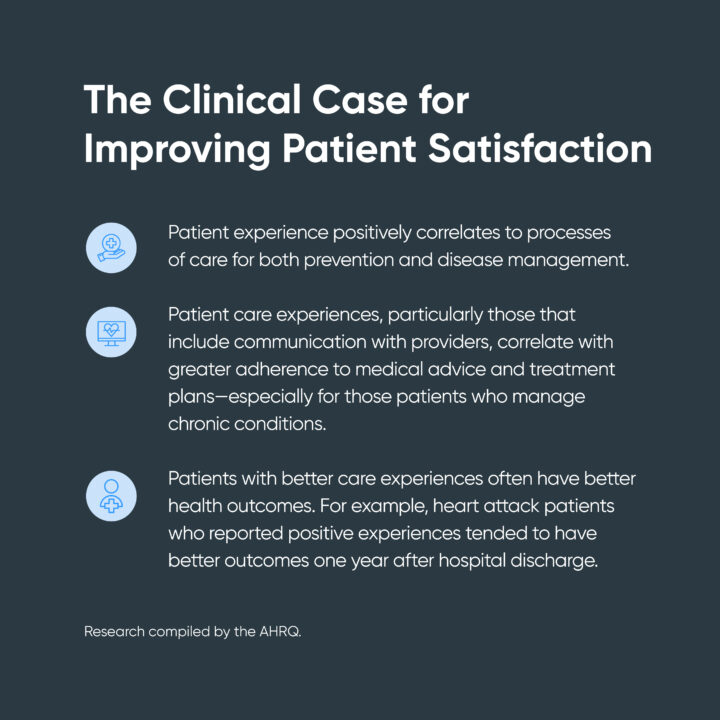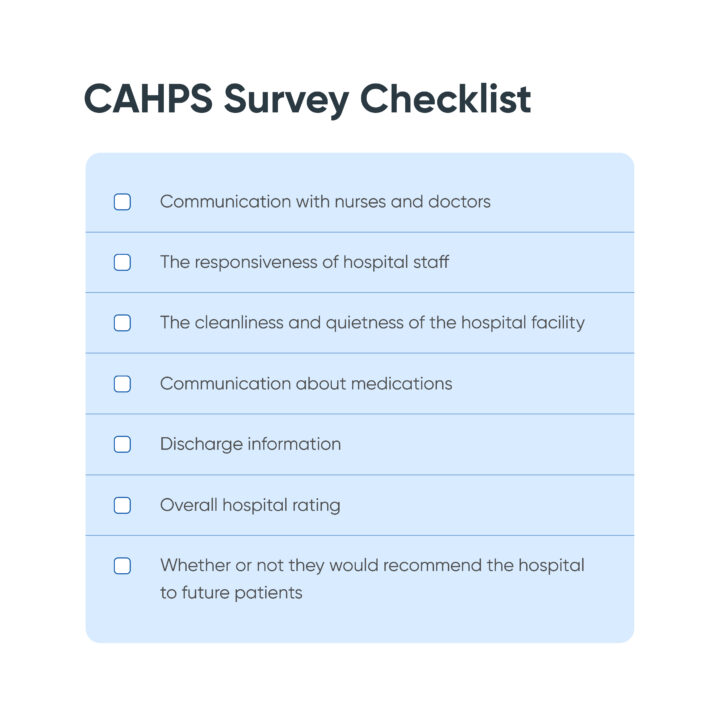Join our mailing list
Receive exclusive updates on the latest CX trends, events,
and solutions.

The terms patient satisfaction and patient experience are often used interchangeably. While you can’t have high patient satisfaction without a positive patient experience, these terms include key differences that are worth distinguishing.
Patient experience refers to the touchpoints and channels that make up patients’ interactions with their provider and care team throughout their entire journey.
Patient satisfaction seeks to understand the way patients feel about the care they receive through these disparate touchpoints and channels, including perceived quality of care, access to care, and understanding of their care plan.
“[Patient satisfaction] is about whether a patient's expectations about a health encounter were met. Two people who receive the exact same care, but who have different expectations for how that care is supposed to be delivered, can give different satisfaction ratings because of their different expectations.”
The Agency for Healthcare Research and Quality (AHRQ)
It’s important to note that patient satisfaction is an innately subjective measure of the healthcare experience (HX). Two patients with similar experiences may generate very different levels of satisfaction depending on each patient’s expectations for their care.
Consider a simple example. Patient A, who is tech-savvy and can easily navigate a digital portal to complete a pre-appointment questionnaire may react positively to this type of self-service offer via email. Whereas Patient B, who is uncomfortable online and prefers the personal touch of a phone call with a live agent, may have a very different reaction to a prompt to complete the same pre-appointment questionnaire.

As the previous example showcases, patient satisfaction can be a tricky outcome to predict. When two patients receive the same care plan and interactions but have markedly different levels of satisfaction, it underlines the need for a provider engagement strategy that offers both flexibility and personalization to achieve each patient’s preferred level of care. Segmenting the patient population and measuring satisfaction allows healthcare organizations to optimize their care strategies and patient journeys to deliver exceptional experiences that make more patients happy — and, more importantly, make them feel cared for at critical moments in their healthcare journey.
However the incentive for healthcare providers to focus on measuring and improving patient satisfaction goes deeper than that. Since 2010, the passage of the Affordable Care Act (ACA) has slowly changed reimbursement models to emphasize value-based care over the fee-for-service model. Under this new directive, healthcare organizations are rewarded for the quality of the care they deliver, as opposed to the quantity of services they provide. Quality in this case is defined by better outcomes and lower costs — but also increased patient satisfaction. The change in policy stems from a growing body of research suggesting that a patient’s perception of care can help drive better patient outcomes.

At the same time, patient decision-making has undergone its own revolutionary transition. As more patients enter high-deductible health insurance plans, the incentive to find affordable, effective care has also risen. With many patients facing thousands of dollars in up-front costs before they hit deductible thresholds, it becomes critically important that they feel they are receiving care that is commensurate with the high cost.
This consumerization of the healthcare industry has created a growing segment of the patient population that looks to leading retail experiences as the new standard for their healthcare experiences — and it means healthcare organizations must now compete against those last best Experiences. Hospital systems and clinics that fail to live up to these standards are at a greater risk of losing these patients. According to one Adobe Consumerization of Healthcare Survey, among those respondents who reported they were less loyal to their regular providers, their top reason for declining loyalty was that they were “more concerned with service than relationship.”
Between rapidly declining patient loyalty, reduced reimbursement and rising expectations, healthcare organizations are quickly realizing they have more revenue on the line than ever before.
Healthcare providers now find themselves in the middle of a rapidly changing competitive landscape. For one, the next few years project flattening economic growth in the healthcare sector. Yet, non-acute, technology-enabled, multichannel care offerings represent one key care area that is bucking this trend. While the total annual revenues of U.S. telehealth players were estimated at $3 billion before COVID, one McKinsey study projects up to $250 billion of current U.S. healthcare spend could now be virtualized in the post-COVID world.
New players are flooding into the healthcare space to begin to capitalize on this multi-billion-dollar opportunity. As a result, legacy providers face an uphill battle to hold on to their patients and their healthcare dollars. However, they’re also better equipped with the tools, resources and insights they need to measure and deliver high-quality omnichannel patient experiences than they were in the pre-ACA era.
Implemented in 2006 to begin capturing valuable patient perspectives of care, the Consumer Assessment of Healthcare Providers and Systems (CAHPS) is a survey instrument and data collection methodology that randomly selects patients and uses a standard survey to measure their perception of recent hospital care.
These surveys are administered by the Centers for Medicare and Medicaid Services, and they include 29 standard questions that ask about critical aspects of each patient’s hospital experience. Surveys are generally presented to patients between 48 hours and six weeks after discharge.

Through CAHPS surveys, healthcare organizations can get a feel for whether their healthcare experiences are accomplishing their goals (i.e. helping a patient schedule an appointment or speeding up the check-in process). But they can also unlock additional insights that help them understand if their ecosystem of omnichannel experiences is living up to patient expectations.
For CAHPS patient data to help drive initiatives that will support long-term patient satisfaction improvement, healthcare organizations need to make sure they have cultivated an environment conducive to sustaining quality of care improvements. This starts with alignment between the quality assurance team, patient experience team and leadership, but it also requires alignment with many other departments to get right — including marketing, IT, employee experience, and clinical care teams. Direct customer communication and easy-to-use digital tools are the center of any patient experience, but it’s how each of these individual resources come together throughout the entire customer journey that creates a truly satisfying one.
Once you have the right team in place to track and implement patient satisfaction initiatives, it’s time to turn to the data itself. At a high level, here are three quick strategies providers can use to make sure they are maximizing the insights they collect from their survey data.
Let’s start with what CAHPS is and what it isn’t. While CAHPS is a valuable tool to help diagnose patient satisfaction issues and monitor improvement over time, it isn’t a one-step roadmap to more satisfying patient experiences. To turn CAHPS surveys into a powerful improvement strategy, it’s up to the patient experience team to chart the journey forward.
To help your organization start this journey, here is a simple three-step process you can use to help define your improvement North Star.

Patients can’t be grouped in one large bucket of “averaged experiences.” Remember our example earlier that addressed the different reactions to the same patient experience from Patient A and Patient B? To truly know your patients, healthcare brands must throw their assumptions out the door. Using supplementary research tools, such as Voice of the Customer (VoC) programs, to gain a more nuanced understanding of patient needs and expectations across existing communication channels is one way leading healthcare organizations are digging deeper. Soliciting additional feedback through routine surveys, reviews and on-the-spot patient interviews can also help provide useful context organizations can use to better understand their CAHPS scores.
Once you understand your patients — and their expectations — you can move to step two: “Help me.” In the modern healthcare environment, this “help me” directive might be more appropriately termed, “help me… help myself.” In clinical care, shared decision-making — by which patients and clinicians agree on the term of the care to ensure efficacy and adherence—has grown as patients seek to take control of their care and their healthcare costs. From a digital care perspective, this likely means integrating easy-to-navigate self-service options via a digital front door that patients can use to move through their journey at their own pace. Informative content, personalized communication techniques and a clear call to action at every step are critical elements of a helpful patient experience strategy.
The last aspect of building a differentiated healthcare experience is demonstrating how much you value your patients—value their outcomes, their experiences, and their budgets. In a consumer-driven healthcare environment, this means creating truly exceptional patient experiences that stand out from a sea of competitors. To achieve this elusive goal, providers should focus on experiences that weave together omnichannel flexibility, technological ease-of-sue, and the human touch into a cohesive healthcare journey.
The importance of patient satisfaction in modern healthcare is clear. Not only is it tied to better patient outcomes, but its emerging impact on the bottom-line health of your business is simply too critical to ignore.
For nearly 50 years, TTEC Digital has been laser-focused on solving the complex and evolving challenges healthcare organizations face. By combining our healthcare industry experience with our cutting-edge, end-to-end design and orchestration services, TTEC Digital is uniquely qualified to both customize and implement innovative HX programs that can help future-proof your organization and empower your teams to respond to a dynamic healthcare environment.
TTEC Digital can help your organization:
As patient expectations continue to move toward the seamless, omnichannel interactions found in the modern retail customer experience, healthcare organizations must understand and adapt to their patients’ unique preferences. Gathering high-quality customer data is a crucial first step in any healthcare transformation. These insights can help inform supportive patient experience strategies that drive greater satisfaction across every healthcare interaction — from scheduling to diagnosis, to reaching out to clinicians, and even paying bills.
{{cta-block-1}}